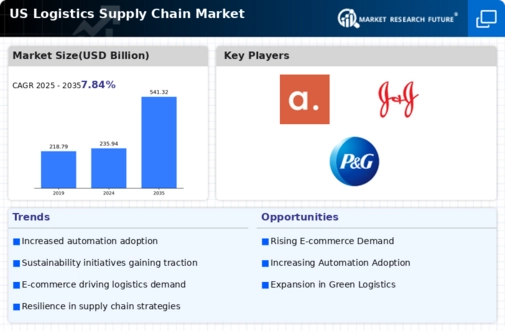The logistics supply-chain market in the US is characterized by a dynamic competitive landscape, driven by technological advancements, evolving consumer expectations, and a growing emphasis on sustainability. Major players such as FedEx (US), UPS (US), and DHL (DE) are at the forefront, each adopting distinct strategies to enhance their operational efficiency and market presence. FedEx (US) focuses on digital transformation, leveraging AI and automation to optimize delivery processes, while UPS (US) emphasizes sustainability initiatives, aiming to reduce its carbon footprint through electric vehicle integration and alternative fuel sources. DHL (DE), on the other hand, is investing heavily in supply chain resilience and innovation, particularly in e-commerce logistics, which has become increasingly vital in the current market environment.
The competitive structure of the logistics supply-chain market appears moderately fragmented, with a mix of large multinational corporations and regional players. Key tactics employed by these companies include localizing manufacturing to reduce lead times and optimizing supply chains through advanced analytics. This collective approach not only enhances operational efficiency but also allows for greater responsiveness to market demands, thereby shaping a competitive environment that is both challenging and opportunistic.
In October 2025, FedEx (US) announced a strategic partnership with a leading technology firm to develop an AI-driven logistics platform aimed at streamlining operations and improving customer service. This move is likely to enhance FedEx's competitive edge by enabling more precise demand forecasting and inventory management, ultimately leading to improved service levels and customer satisfaction. Similarly, in September 2025, UPS (US) unveiled its new sustainability program, which includes a commitment to achieve carbon neutrality by 2050. This initiative not only aligns with global sustainability trends but also positions UPS as a leader in environmentally responsible logistics, potentially attracting eco-conscious clients.
In August 2025, DHL (DE) launched a new service focused on last-mile delivery solutions tailored for urban areas, utilizing electric vehicles and bicycle couriers. This strategic initiative reflects DHL's commitment to innovation and sustainability, addressing the growing demand for efficient and environmentally friendly delivery options in densely populated regions. By enhancing its last-mile capabilities, DHL is likely to strengthen its market position and appeal to a broader customer base.
As of November 2025, the logistics supply-chain market is increasingly defined by trends such as digitalization, sustainability, and the integration of AI technologies. Strategic alliances among key players are shaping the competitive landscape, fostering collaboration that enhances service offerings and operational capabilities. Looking ahead, it appears that competitive differentiation will increasingly pivot from traditional price-based competition to a focus on innovation, technology integration, and supply chain reliability. Companies that successfully navigate these trends are likely to emerge as leaders in a rapidly evolving market.

















Leave a Comment